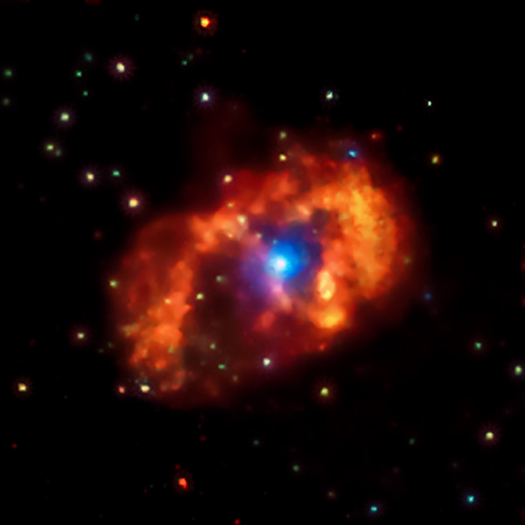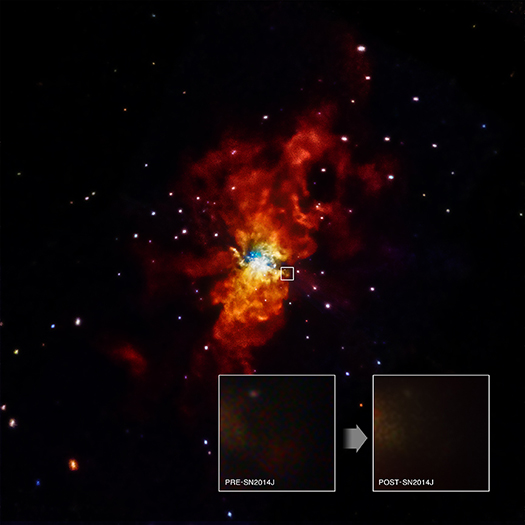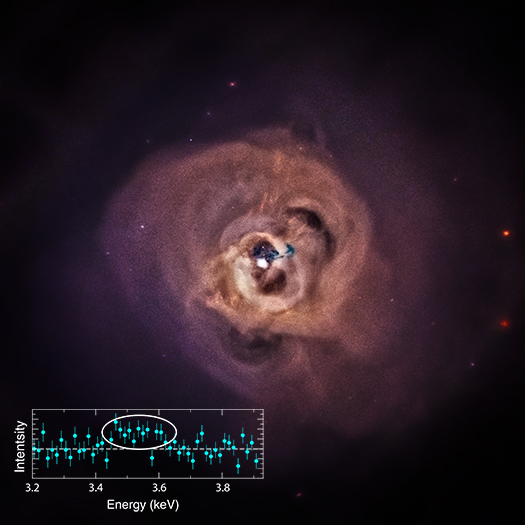An X-ray Tapestry
The destructive results of a powerful supernova explosion reveal themselves in a delicate tapestry of X-ray light, as seen in this image from NASA's Chandra X-Ray Observatory and the European Space Agency's XMM-Newton.
Our Neighboring Superstars
The Eta Carinae star system does not lack for superlatives. Not only does it contain one of the biggest and brightest stars in our galaxy, weighing at least 90 times the mass of the Sun, it is also extremely volatile and is expected to have at least one supernova explosion in the future.
NASA's Chandra Observatory Searches for Trigger of Nearby Supernova
New data from NASA's Chandra X-ray Observatory has provided stringent constraints on the environment around one of the closest supernovas discovered in decades. The Chandra results provide insight into possible cause of the explosion, as described in our press release.
Harvey's Voyage

Dr. Harvey Tananbaum at the Smithsonian's Castle Library in May 2006. (Credit: Jim Moran)
Chandra, me, and the number 23
A month or two after Chandra launched in July 1999, I was asked at a Chandra X-ray Center (CXC) senior staff meeting how long I actually expected Chandra to operate. I spontaneously responded: "23 years". Now that is a number not heard very frequently, so there were lots of quizzical looks indicating that an explanation was in order.
Let’s get the Carnival started!
Here is a roundup of blog articles for #astrolovers from around the web this week:
Galactic Pyrotechnics On Display
A galaxy about 23 million light years away is the site of impressive, ongoing, fireworks. Rather than paper, powder, and fire, this galactic light show involves a giant black hole, shock waves, and vast reservoirs of gas.
Nanda Rea Wins Award for Solving a Magnetic Mystery

Nanda Rea. Credit: N. Rea
Last week, the Committee on Space Research (COSPAR) announced the awards that will be presented at their upcoming meeting in August in Moscow. One of the winners of the Yakov B. Zeldovich Medals -- a joint award of COSPAR and the Russian Academy of Sciences conferred on young scientists for excellence and achievements – will go to Nanda Rea.
Dr. Rea is an assistant professor at the Institute of Space Sciences (CSIC-IEEC) in Barcelona and the Anton Pannekoek Institute (API) at the University of Amsterdam. She has spent much of her career studying magnetars, a special class of neutron stars that have some of the strongest magnetic fields in the Universe.
A Flash in the Dark!

We are delighted to welcome Esra Bulbul as a guest blogger. Esra led the new study reporting evidence for a mysterious X-ray signal in galaxy clusters, leading to our latest press release. She earned her master’s degree in physics from the Middle East Technical University in the capital city, Ankara, in Turkey in 2006. Four years later she graduated with a PhD in physics from the University of Alabama in Huntsville / NASA Marshall Space Flight Center. After receiving her Ph.D. she moved to the Harvard-Smithsonian Center for Astrophysics as a Smithsonian Astrophysical Fellow working jointly at the NASA Goddard Space Flight Center as a visiting scientist. She is now back at the Harvard-Smithsonian Center for Astrophysics and enjoys living in the greater Boston area.
When I started my first postdoc at the Harvard-Smithsonian Center for Astrophysics, I already knew that one alternative way to improve the sensitivity of current instruments like Chandra and XMM-Newton is to “stack” large numbers of observations of galaxy clusters, meaning that we layer one observation on top of another.
The great advantage of stacking observations is not only an increased signal-to-noise ratio (that is, the amount of useful signal compared to background noise), but also the diminished effects of detector and background features. The X-ray background emission and instrumental noise are the main obstacles in the analysis of faint objects, such as galaxy clusters.
Mysterious X-ray Signal Intrigues Astronomers
A new study of the Perseus galaxy cluster, shown in this image, using NASA's Chandra X-ray Observatory and 73 other clusters with ESA's XMM-Newton has revealed a mysterious X-ray signal in the data. This signal is represented in the circled data points in the inset, which is a plot of X-ray intensity as a function of X-ray energy. The signal is also seen in over 70 other galaxy clusters using XMM-Newton. This unidentified X-ray emission line - that is, a spike of intensity at a very specific energy, in this case centered on about 3.56 kiloelectron volts (keV) - requires further investigation to confirm both the signal's existence and nature as described in the latest Chandra press release.





